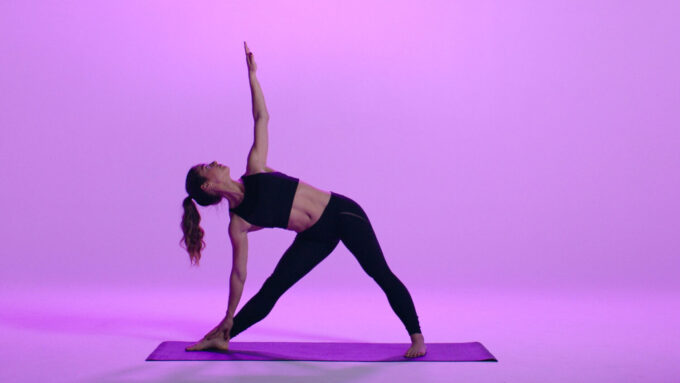Yoga is a practice that has been embraced by millions around the world for its incredible physical and mental health benefits. Whether you’re looking to improve flexibility, reduce stress, or enhance your overall well-being, yoga offers a wide range of advantages. But if you’re a beginner, you might wonder, “How often should I practice yoga?” This guide aims to answer that question and provide valuable insights for beginners embarking on their yoga journey.
The Importance of Regular Yoga Practice for Beginners

Source: omstars.com
Before we delve into the frequency of practice, it’s essential to understand the significance of regular yoga exercises, especially for beginners. This activity is not just about physical postures; it’s a holistic approach to health and wellness. Regular practice can help you build a strong foundation and reap the full benefits of this ancient exercises.
Benefits of Regular Yoga Practice
Regular yoga practice offers a multitude of physical and mental benefits that can transform your life. Let’s explore some of these benefits to motivate you on your yoga journey and give you a Yoga guide.
Physical Benefits
Improved Flexibility: Yoga poses, or “asanas,” gradually increase your flexibility, making everyday movements easier.
Enhanced Strength: Many yoga poses require you to support your body weight, helping you build muscle strength.
Better Posture: This activity encourages awareness of your body and alignment, leading to improved posture.
Pain Relief: It can alleviate chronic pain conditions like back pain and arthritis.
Mental Benefits
Stress Reduction: Yoga includes relaxation techniques that reduce stress and promote mental calmness.
Enhanced Focus: The mindfulness cultivated in this activity can improve concentration and mental clarity.
Emotional Balance: Regular exercises help regulate emotions and promote a sense of inner peace.
Better Sleep: It can improve sleep quality and help with insomnia.
With these incredible benefits in mind, let’s explore how often beginners should exercise yoga to harness them.
Setting Realistic Goals
As a beginner, it’s crucial to set achievable goals when starting your yoga practice. Avoid the temptation to overcommit; consistency is the key to progress. Start with realistic expectations and gradually increase your exercises frequency as you become more comfortable with the postures and routines.
Emphasizing Consistency

Source: blog.yogamatters.com
Consistency is vital in yoga practice. It’s better to exercise for a shorter duration consistently than to do long sessions sporadically. Aim for regular practice, even if it means starting with just a few minutes each day.
Frequency Recommendations
Now, let’s address the central question: How often should beginners exercise this activity? The answer varies based on individual preferences, goals, and schedules. Here are some recommendations to consider:
Daily Yoga Exercises
Practicing yoga daily offers several advantages:
Continuous Progress: Daily practice allows for steady improvement in flexibility, strength, and mental focus.
Establishing Routine: It becomes a daily habit, making it easier to incorporate into your lifestyle.
Stress Reduction: Daily practice can significantly reduce stress levels.
However, daily exercises can be challenging due to busy schedules. Here are some tips to maintain a daily yoga routine:
Short Sessions: If time is limited, opt for shorter, focused sessions.
Set Reminders: Schedule this activity into your day, and set reminders to stay on track.
Variety: Explore different yoga styles to keep daily practice interesting.
Weekly Practices

Source: nytimes.com
For those with busier schedules, practicing yoga a few times a week is still beneficial. Here’s why:
Flexibility: Weekly exercises allow you to choose days that fit your schedule.
Balancing Act: It’s easier to balance yoga with work, family, and other activities.
Physical Benefits: You can still enjoy physical benefits with less frequent practice.
Consider combining studio classes with home exercises to maintain consistency.
Biweekly or Monthly Yoga Practice
Even practicing this activity biweekly or monthly can provide benefits, especially if you focus on quality over quantity. Here’s how it can work for beginners:
Intensive Practice: Longer sessions can be more intensive, allowing you to dive deeper into poses.
Recovery Time: More extended gaps between sessions provide ample time for recovery.
Mindful Practice: You can be more mindful and present during each session.
Importance of Rest Days
Regardless of your practice frequency, rest days are crucial. Yoga is not about pushing your body to its limits every day. Rest days allow your body to recover and prevent burnout or injury. Listen to your body and take the rest you need.
Adapting to Your Schedule

Source: typelish.com
Incorporating yoga into a busy schedule might seem challenging, but it’s possible. Here are strategies to help you make time for this activity:
Short Sessions: If your schedule is tight, opt for short yoga sessions, even as brief as 10-15 minutes.
Morning or Evening: Choose a time that aligns with your daily routine, whether it’s in the morning to energize your day or in the evening to unwind.
Online Classes: Explore online yoga classes that offer flexibility in timing.
Personalized Practice Frequency
Every individual is unique, and there’s no one-size-fits-all answer to how often you should practice this activity. Factors like age, fitness level, and personal goals play a role. Listen to your body and adjust your practice frequency accordingly.
For example, younger individuals may have more energy for daily practice, while older practitioners may benefit from a gentler approach. If your goal is stress reduction, you might find that a few weekly sessions suffice.
Monitoring Progress
Tracking your progress is essential to stay motivated and see how far you’ve come. Keep a yoga journal to record your practice frequency, the poses you’ve mastered, and how you feel after each session. Consistency is the key to achieving milestones and witnessing positive changes in your body and mind.
Conclusion and Key Takeaways
In conclusion, regular yoga practice offers a multitude of physical and mental benefits for beginners. The frequency of practice can vary from daily to biweekly or even monthly, depending on your preferences and schedule. Emphasize consistency, set realistic goals, and don’t forget the importance of rest days.
As you embark on your yoga journey, remember that it’s a personal experience. Listen to your body, adapt your practice to your unique needs, and enjoy the transformation that this activity can bring to your life. Start with a practical and sustainable practice frequency, and you’ll reap the rewards of this ancient practice. Namaste!






